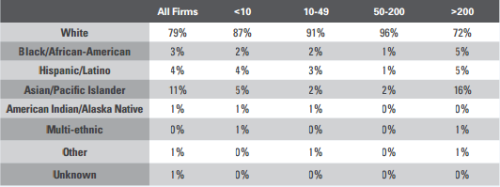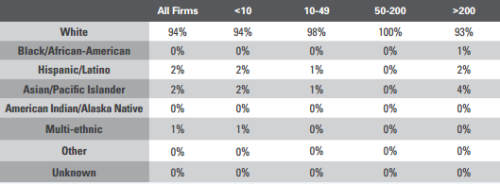Subscribe for Weekly Updates

Stop Talking and Start Changing
By Lori Braden, Vice President, Strategic Marketing
The National Association of Black Accountants was founded in 1969. The Association for Latino Professionals in Finance and Accounting was founded in 1972. The National Asian American Society of Accountants was founded in 2005. Yet, according to the AICPA’s 2011 Trends Report, minorities represent 21 percent of the accounting profession. Here’s a closer look:

Professional Staff Demographics by Firm Size

Partner Demographics by Firm Size
The Philadelphia Business Journal recently published a special report, The Quest for Diversity: Accounting Lags Behind that discusses how the profession’s poor performance trails others in recruiting and maintaining minorities.
Are you rolling your eyes yet? I’ve been to enough Diversity Committee meetings and events to guess that you probably are, if you’ve even read this far down the page. Some of the rebuttals I often hear:
- The talent pool is too small.
- I hire the best candidates, regardless of race or ethnicity.
- The “Big Four” have bigger recruiting budgets and snap up the best candidates.
- I am not filling quotas.
Regardless of the rebuttals, let’s look at the issue purely from a business standpoint—forget about “doing the right thing” for a moment.
The U.S Census Bureau reports that 1 in 3 residents is a minority. By 2050, minorities will become the majority of the U.S. population. So I ask you this…if 1/3 of the faces walking down the street are reflected by only 21 percent of a profession, does that profession fail to attract a growing segment of the population it serves? Changing demographics are also reflected in other segments of the business community:
There were 5.8 million minority-owned businesses in 2007, an increase of 45.6 percent from 2002:
- 2.3 million businesses owned by Hispanics
- 2.3 million businesses owned by Asians
- 1.9 million businesses owned by Blacks or African Americans (fastest growing segment of business owners)
An article from the spring 2011 Pennsylvania CPA Journal highlights:
The number of minorities that are business owners or occupy top roles in the Pennsylvania business community continues to grow. The types of businesses run the gamut: from restaurant, gas station, and convenience store owners, to engineers, doctors, hotel owners, and so on. Organizations looking to do business with those companies need to ask, ‘Do we have the know how, the understanding, and the in-house human capital to be able to fully understand the culture, needs, and sensitivities of our minority clients?’
Organizations who want to be successful in a global marketplace, expand client services, and have the strongest staff leading the way, need a diverse staff.
The PICPA Diversity Committee is currently working on a white paper to present the business case for minority hiring, as well as a toolkit geared to local and regional firms to support their recruiting and retention efforts. While the larger firms have made strides in minority hiring, we recognize smaller firms don’t have the financial and human capital to develop similar programs. This paper, which will be released in the fall 2012, should provide some insight into how firms of all sizes can maintain a competitive edge in an ethnically diverse business environment.
Minority recruitment and retention truly is about doing the right thing…if you want your business to continue to grow and thrive.







Leave a commentOrder by
Newest on top Oldest on top